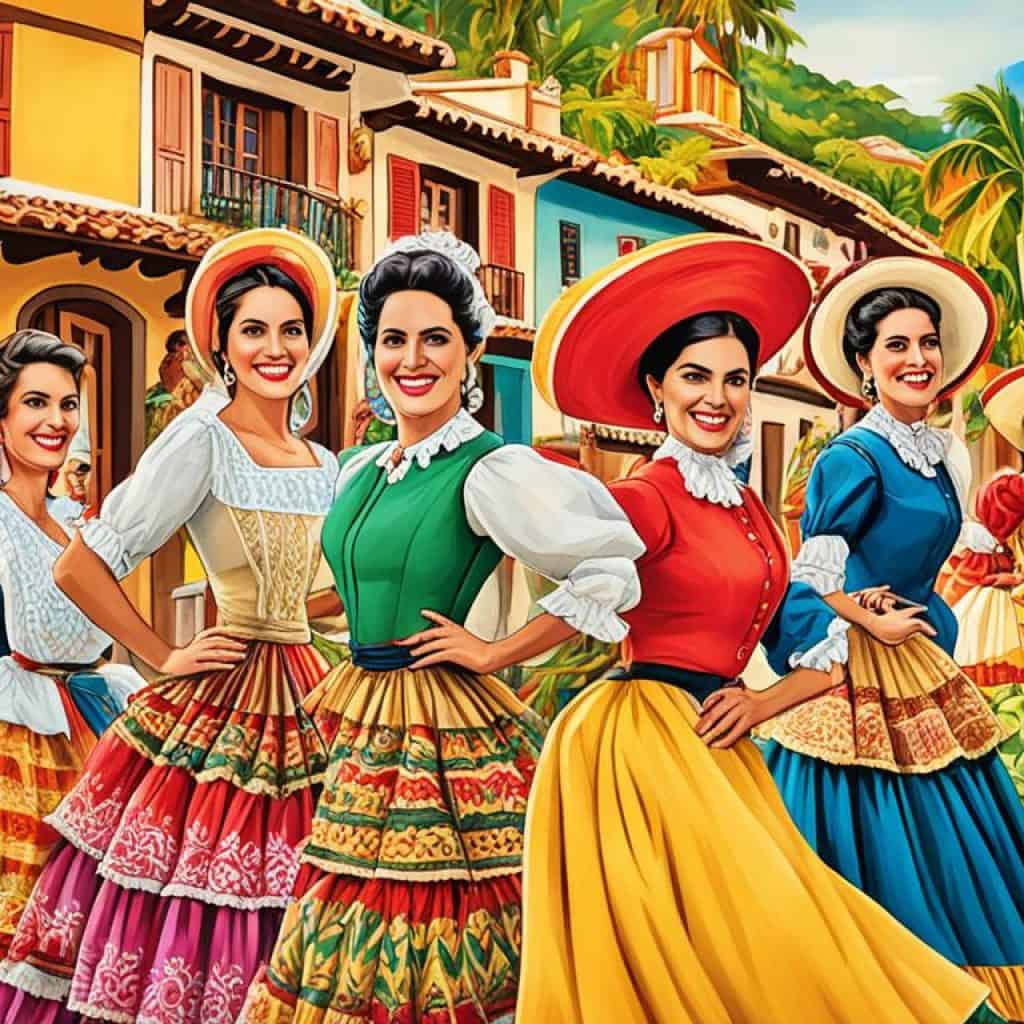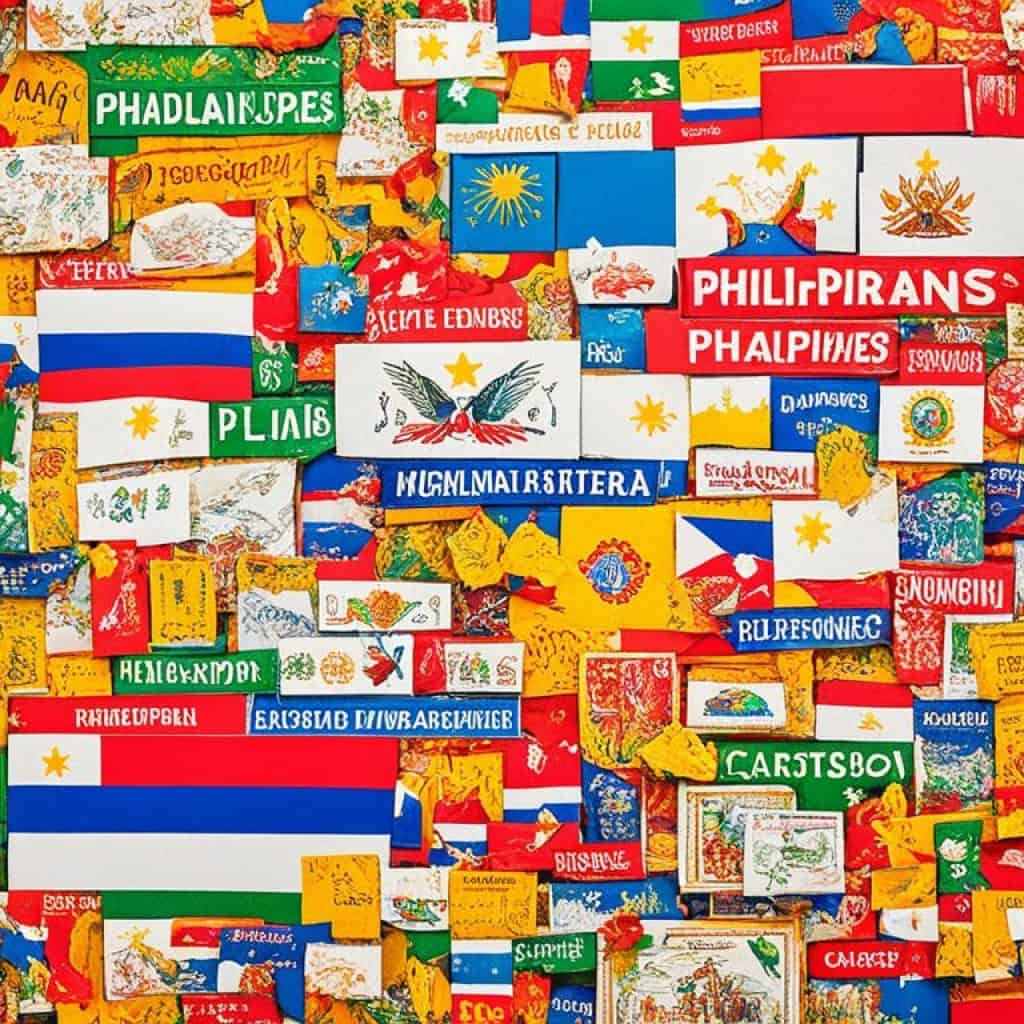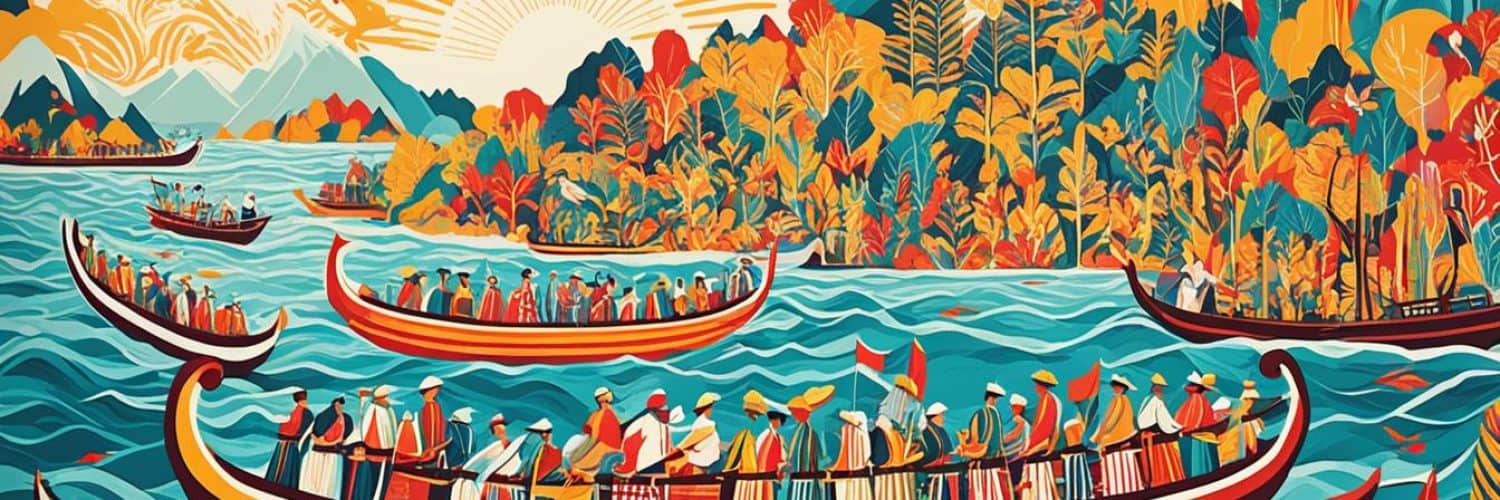Have you ever thought about where the Tagalog language comes from? How it grew and became the main language in the Philippines? Let’s take an exciting look at Tagalog’s history. We’ll see how it started and understand its importance.
Key Takeaways:
- Tagalog, the national language of the Philippines, has Austronesian origins.
- The migration of Austronesian-speaking peoples to the Philippine archipelago led to the development of diverse regional languages and dialects.
- Spanish colonization had a profound influence on Tagalog, resulting in the incorporation of Spanish loanwords and changes in syntax and grammar.
- Before Spanish colonization, the Tagalog people used the Baybayin script to write their language.
- Filipino, based on Tagalog, became the official national language, but regional languages and dialects continue to be important.
The Austronesian Origins of the Tagalog Language
The Tagalog language is part of the Austronesian family, one of the biggest language groups globally. It started with the Austronesian-speaking peoples moving from Taiwan to the Philippines between 2,000 and 3,000 years ago.
These first settlers traveled to the Philippines and made homes by rivers and seas. This arrival played a big role in the area’s history. It shaped the language and culture of the Filipino people.
The roots of the Tagalog language in the Austronesian family show the rich language history of the Philippines. This family includes many languages from Southeast Asia, the Pacific, and East Africa. It shows the wide travels and cultural mixing of ancient Austronesian peoples.
The Austronesian-speaking peoples shaped the history and language of the Philippines, leaving a lasting impact on the cultural diversity of the region.
The move of these peoples to the Philippines set the stage for the birth of many languages, including Tagalog. Over time, local and outside influences shaped different languages and dialects in the region.
The roots of Tagalog in the Austronesian family show how languages in the Philippines and beyond are connected. Knowing these roots teaches us about the country’s linguistic and cultural variety.
Key Points:
- The Tagalog language belongs to the Austronesian language family.
- Austronesian-speaking peoples migrated from Taiwan to the Philippine archipelago around 2,000 to 3,000 years ago.
- Settlements established by the ancestors of the Tagalog people played a significant role in shaping the region’s history.
- Austronesian languages exhibit a shared heritage and interconnectedness seen across Southeast Asia and the Pacific.
| Tagalog Language | Translation | Language Family |
|---|---|---|
| Tagalog | Aikee | Austronesian |
| Hiligaynon | Kasandaga | Austronesian |
| Cebuano | Tabay | Austronesian |
| Ilocano | Pudno | Austronesian |
Diverse Austronesian Languages in the Philippines
The Austronesian settlers met many indigenous groups when they came to the Philippines. This meeting led to many regional languages and dialects. This variety shows the rich cultural mix of the Filipino people.
The Philippines’ Austronesian languages have features that make them stand out. They use infixes, affixes, and reduplication for emphasis. This adds depth and meaning to their communication.
The country’s linguistic scene shows its complex history and varied ethnic groups. Each regional language and dialect offers a peek into the cultural legacy of the local communities. It creates a vibrant language mosaic.
“The diverse Austronesian languages in the Philippines are a reflection of the rich tapestry of cultures and traditions that exist within the archipelago.” – Dr. Maria Santos, Linguistics Expert
Despite many languages, Tagalog plays a key role in-uniting Filipinos. It helps people from different regions talk and understand each other. It acts as a common language for everyone in the country.
Languages and Dialects in the Philippines:
| Language/Dialect | Region |
|---|---|
| Tagalog | Central Luzon, CALABARZON, Metro Manila, and other parts of Luzon |
| Cebuano | Visayas and Mindanao |
| Ilocano | Ilocos Region and parts of Cagayan Valley and Cordillera Administrative Region |
| Hiligaynon | Western Visayas and Soccsksargen |
| Waray | Eastern Visayas |
There are many languages and dialects in the Philippines. Each language shows a different cultural identity and heritage. This diversity makes the Philippines a very interesting and unique country.
Baybayin – The Ancient Script of the Tagalog People
Before the Spaniards came, the Tagalog people used Baybayin as their writing system. This script had syllabic characters that were very important. They used it to record history, keep cultural knowledge, and for art. It linked their spoken stories to the written word.
Baybayin was key to Tagalog culture. It captured their language and showed the Filipino identity. People wrote with it on palm leaves, tree bark, and bamboo. This script celebrated their heritage and showed it visually.
Baybayin showed the Tagalog people’s deep bond with their language and history. It wasn’t just for writing. It was a symbol of who they were and helped keep their culture alive.
Baybayin characters stood for syllables. This let the Tagalog write using special character combinations. The script’s smooth and artistic strokes linked their culture’s visual and spoken aspects.
But when the Spanish came, Baybayin started to disappear. It was eventually replaced by the Latin alphabet. Still, Baybayin’s impact on Tagalog culture and language lives on.
The Baybayin Script and Contemporary Culture
Today, Baybayin isn’t used much in the Philippines, but interest has been growing. Filipinos and scholars are working to bring it back. They see its value in keeping the Tagalog linguistic heritage.
Baybayin is showing up in today’s culture too. Artists use it in their work, like paintings, tattoos, and jewelry. These works celebrate Tagalog culture and keep Baybayin alive today.
| Baybayin Characters | Corresponding Syllables |
|---|---|
| ᜀ | a |
| ᜁ | e/i |
| ᜂ | u/o |
| ᜃ | ka/nga |
| ᜄ | ga |
| ᜅ | ta |
| ᜆ | da |
Baybayin: A Cultural Treasure
The Baybayin script is a key piece of Tagalog culture. Spanish colonization changed its use, but not its importance. Reviving Baybayin helps us reconnect with our past and honor our ancestors’ language and art.
The Baybayin script today symbolizes Tagalog culture. It keeps the ancient language roots alive and shows the Filipino spirit.
Spanish Colonization and the Influence on Tagalog
In the 16th century, the Spanish made a big impact on Tagalog. They came to the Philippines and started communities. This changed Tagalog a lot.
Spanish added new words to Tagalog. Words like “mesa” (table), “silya” (chair), and “silid” (room) came from them. These words showed how both cultures mixed.
The Influence on Vocabulary and Syntax
Tagalog grew by adding Spanish words. This change affected how sentences were built. It even changed verb use and the grammar.
“Spanish colonizers and Tagalog people mixed their cultures. This mix changed our words and how we make sentences,”
The Replacement of the Baybayin Script
Before the Spanish came, Tagalogs used the Baybayin script. The Spanish introduced the Latin alphabet. This was a big shift in Tagalog writing.
The Latin alphabet helped spread Tagalog writing. It allowed writers to try new styles and share Tagalog culture.

The Legacy of Spanish Influence
The Spanish left a strong mark on Tagalog. Their words are still used today, adding to the language’s richness. This blend of traditions made the Philippine culture richer.
Spanish influence touches many parts of Filipino culture. Understanding this influence helps us see how the Filipino identity was shaped.
Chavacano – A Mix of Spanish and Tagalog
Chavacano is a fascinating blend of languages born from the Spanish colonizer’s footprint. It interestingly combines Spanish with touches of Visayan, Tagalog, and other local dialects.
In places like Cavite, Chavacano became more than just a language. It symbolized identity and unity among diverse communities. This creole language marks the rich cultural blend in the Philippines, showcasing the strong Spanish influence.
Chavacano Language Characteristics:
- Incorporates Spanish vocabulary and grammatical structures
- Uses Tagalog, Visayan, and other local languages as foundational elements
- Reflects the unique history and cultural blending of the regions where it developed
Chavacano’s growth underscores how languages can evolve and adapt. It is a living symbol of the Philippines’ cultural wealth.
Example of Chavacano:
“Ay nang deligao te gatrim?”
A phrase in Chavacano, meaning “Where are you going?”
A Comparison of Chavacano, Spanish, and Tagalog
| Language | Influence |
|---|---|
| Chavacano | A mix of Spanish, Visayan, Tagalog, and other local languages |
| Spanish | A significant influence on vocabulary and some grammatical structures |
| Tagalog | Contributed foundational elements and local influences |
The Emergence of Filipino as a National Language
After centuries under Spanish rule, the Philippines aimed to create a national language. This found Tagalog as the base, later named Filipino to include all dialects. As the official language, Filipino signifies the unity and cultural identity goals.
Filipino, the national language, acts as a bridge among the people. It connects different regional languages, promoting communication across the islands. While Filipino is central, the country still honors its linguistic variety, showing the value of diversity.
The rise of Filipino as the national language reflects a desire to protect its culture and a shared identity. By selecting Tagalog as its core, Filipino honors the country’s rich history and traditions. It stands for resilience and unity amid diversity.
Language Unity in the Philippines
In the diverse Philippines, language unity is key. Filipino serves as a common tongue, enabling communication among its people. It helps overcome regional differences, allowing Filipinos to share and connect.
Language unity aids in building cultural connections and preserving national identity. Filipino lets people pass on their heritage, enriching the country’s cultural mosaic. This showcases the Philippines’ unique essence.
“Filipino is more than just a language; it is the embodiment of our shared heritage and the key to understanding our cultural identity. It unites us as one nation while celebrating our linguistic diversity.”
The rise of Filipino as the national language underlines the Philippines’ dedication to unity and cultural preservation.
The Significance of Cultural Identity
Cultural identity is vital for Filipinos, rooted in their history, customs, and language. Filipino plays a critical role in keeping this identity alive across the nation.
By using Filipino, the nation can share its values and knowledge with the next generations. It’s a tool for fostering Filipino pride and celebrating the nation’s unique cultures. Filipino helps protect the Philippines’ rich heritage.
Filipino: A Language of Pride and Unity
Adopting Filipino as the national language showcases the unity and pride of the Filipinos. It unites linguistic differences, creating a common identity. Filipino reflects efforts to honor the country’s culture and unity.
With Filipino as the official language, the Philippines commits to preserving its diverse heritage. This language links the past with the present and future, nurturing a shared Filipino journey.
The Number of Tagalog Speakers
Tagalog is the national language of the Philippines. It is spoken by about 27 million people in the country. More than 24 million people speak it around the world.
In the United States, many Tagalog speakers live in Nevada, California, and Washington. These communities add to the country’s rich mix of languages. Tagalog is also spoken in Saudi Arabia, the United Arab Emirates, the United Kingdom, and Guam.
The language’s global presence shows how important it is worldwide. It highlights the deep connections different cultures share. Tagalog celebrates the rich cultural heritage and helps people stay in touch with their roots, no matter where they are.
Tagalog Language Speakers by Country
| Country | Estimated Number of Tagalog Speakers (Millions) |
|---|---|
| Philippines | 27 |
| United States | 3 |
| Saudi Arabia | 2 |
| United Arab Emirates | 1.5 |
| United Kingdom | 1 |
| Guam | 0.5 |
“The bond between language and culture is unbreakable, transcending borders and connecting people from different corners of the world.” – Author Unknown
The Status of Tagalog as the Official Language
In the Philippines, Tagalog isn’t the official language. Instead, the official language is Filipino, which is based on Tagalog. About a quarter of the population speaks Filipino.
Other languages like Visayan, Bikol, and Ilocano are also important. The Philippine Constitution promotes the preservation of these regional languages. This helps keep the country’s cultural identity and language diversity alive.
Language Diversity in the Philippines
The Philippines boasts a rich variety of over 120 languages and dialects. This diversity shows the country’s rich multicultural heritage. Filipino is the official language, but regional languages play a key role too.
Language is the key to understanding different cultures and fostering a sense of unity within the diverse Filipino society.
The Importance of Preserving Regional Languages
Regional languages are crucial in keeping cultural heritage alive. They help build a strong sense of identity within communities. The Philippine Constitution supports this, highlighting regional languages’ role in education and culture.
By valuing linguistic diversity, we enrich our identities and unite the nation.
Major Languages Spoken in the Philippines
| Language | No. of Speakers | Region |
|---|---|---|
| Tagalog | 27 million | Central Luzon, Metro Manila, CALABARZON |
| Visayan (Cebuano, Hiligaynon, Waray) | 33 million | Visayas, Mindanao |
| Ilocano | 10 million | Ilocos Region, Cordillera Administrative Region |
| Bikol | 4 million | Bicol Region |

The Philippines’ language diversity is a beautiful sight. It plays a key role in shaping our local cultures and identities. By recognizing and valuing our linguistic diversity, we support cultural understanding. This also brings us together as Filipinos, celebrating our shared heritage.
The Writing Script of Tagalog
The Tagalog language had its own way of writing called Baybayin script. This script was made of syllabic characters that captured the Tagalog people’s culture and identity. It helped turn spoken stories and traditions into something you could see and touch.
But things changed when the Spanish came to the Philippines. They brought the Latin alphabet which slowly took over the Baybayin script. This change mixed Tagalog writing with English and Spanish sounds and letters.
Today, Tagalog uses the Roman alphabet and it shows how the language has grown. It stands as a sign of how Tagalog has evolved, blending its history with new influences. This mix makes Tagalog an essential part of life in the Philippines.
Interesting Facts About Tagalog
Tagalog is the national language of the Philippines. It has a rich history and unique features. These make it a fascinating language to learn about.
Tagalog Language Facts
Tagalog is spoken by over 70 million people in the Philippines. Most of them are in the Luzon region. Many non-Tagalog speakers also use it as a second language.
“Tagalog is a fascinating language that reflects the cultural diversity and heritage of the Filipino people.”
The official language, Filipino, is based on Tagalog. It includes words from other Philippine languages. This helps connect different linguistic groups.
Tagalog Dialects
Tagalog has many dialects. Each one has its own special qualities. Here are some of them:
- Bulacan – known for its unique intonation and vocabulary.
- Batangas – has a strong accent and special vocabulary.
- Manila – blends influences and accents in the capital region.
- Marinduque – preserves old Tagalog words and expressions.
These dialects highlight the language’s regional and cultural diversity.
The Rise of Taglish
Taglish, a mix of Tagalog and English, is gaining attention. It shows the bilingual nature of the Philippines. English’s influence is also seen, being a key language in schools.
“Taglish has become a popular way of communication, blending the strengths of both Tagalog and English.”
Taglish uses English words, phrases, and grammar in Tagalog sentences. It’s often used in casual settings and social media.
Tagalog Language in Pop Culture
Tagalog is getting known outside of the Philippines. This is thanks to Filipino artists and celebrities. Stars like Vanessa Hudgens and Darren Criss have highlighted their Tagalog skills.
Tagalog is constantly changing and adapting. It remains a vital language that connects to the rich culture and heritage of the Filipino people.
Tagalog and the United States
Tagalog is now a common language in the United States. Many Tagalog speakers live across various states. This shows how important and widespread Tagalog is globally.
“Tagalog is not just a language; it’s an integral part of our culture and identity.”
Famous people in the US love speaking Tagalog too. For instance, Black Eyed Peas members apl.de.ap and Taboo often speak it. They show their strong ties to their Filipino roots.
Celebrities Speaking Tagalog
Meghan Markle, the Duchess of Sussex, amazed many by speaking Tagalog. While in the Philippines, she used Tagalog to connect deeply with the locals.
The number of Tagalog speakers in the US highlights Filipino migration. It shows how the language helps maintain cultural bonds and traditions.
Tagalog’s growth in the US reflects the strong connection Filipinos have with their language. It adds to America’s rich mix of languages and cultures.
Conclusion
The Tagalog language has a rich history. It highlights the resilience and flexibility of the Filipino people. It began from its Austronesian roots and grew through cultural exchanges, local influences, and Spanish rule.
Tagalog is now the national language of the Philippines. It shows the country’s unity, pride, and lasting spirit. From its simple start, Tagalog has included parts from different languages and cultures.
Its changes mirror the complex history of the Philippines. The many influences that have formed the language are seen in its evolution. Through years of changes in language, Tagalog has become a sign of cultural identity and an essential part of Filipino heritage.
Today, millions speak Tagalog both in the Philippines and worldwide. It connects people and communities. It highlights the Philippines’ language diversity while bringing its people together.
Tagalog has made great progress from its beginnings. Its story shows the lasting importance of language and keeping cultural heritage alive.







Add comment